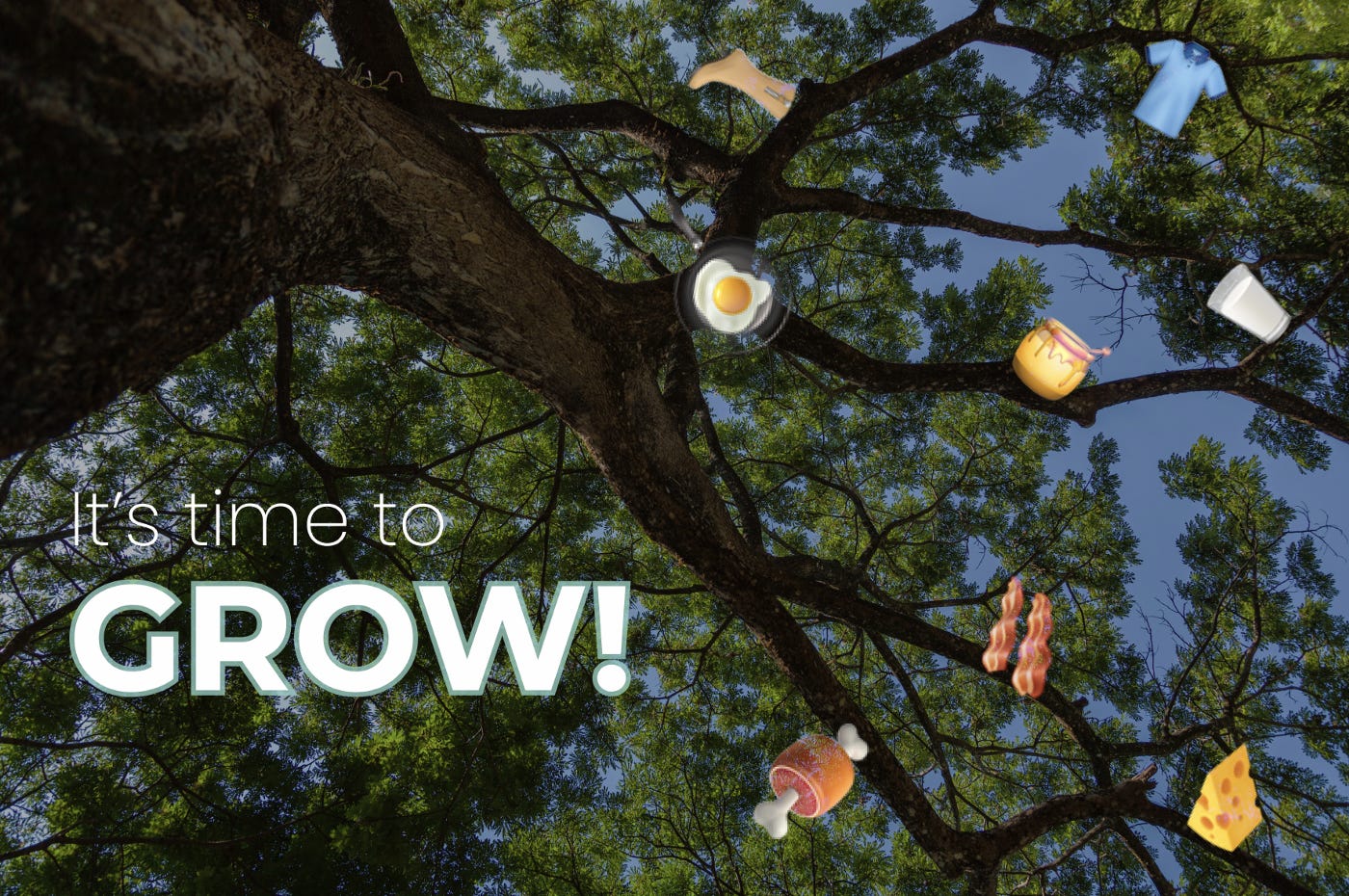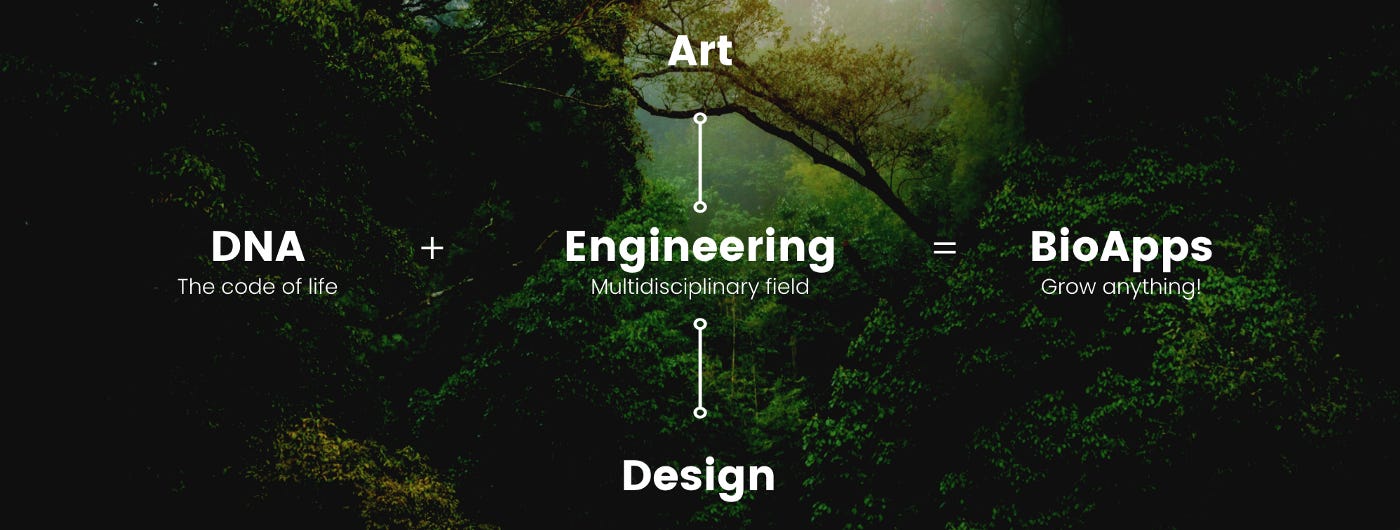Look at your surroundings: your table, your clothes, your food, yourself, and other living creatures. What if we didn’t exploit natural resources to obtain them? What if that was profitable too? What if we could grow anything?
Inspired by Ginkgo Bioworks, I would say that this is one of the promises of synbio. The how is the second promise: biology is technology. Synthetic biology as a discipline is multidisciplinary, and aims to standardize biology so we can become biohackers; organism engineers and developers.
In a simplified manner, cellular agriculture involves differentiating and multiplying cells in the lab through various biotechnologies, including synthetic biology.
More clearly, synbio meets growth in a type of cell ag called acellular agriculture, which grows compounds that aren’t cells, inside of cells. In other words, acellular agriculture is about manufacturing a variety of compounds using synthetic biology.
If you look around you again, one of the first things that you’ll notice is that electronic device in which you’re reading this article. This is digital technology assembled from hundreds of different components (the hardware) and running code (the software).
Biological technology is similar. Despite recent research, we generally use the analogy of DNA being software and cells being hardware. One difference is provided by Neri Oxman: computers are assembled, while nature grows.
That was (probably) it for the romantic and inspirational part of this article. Next, we will dive deep into different types of BioApps — as I like to call biotech products. — The questions to answer are what we are growing and how.
Acell ag science
Perhaps the most important point to understand as an outsider to the deep science of all cell ag is this: these products are the real thing. The how changes, not the what.
Engineers like Elon Musk apply first principles thinking to reinvent things. Bioengineering and cell ag are similar: we reverse engineering nature; ask “what makes [insert organic thing here] itself?”, and then use biotech tools to produce it in a viably, efficiently, and sustainably.
Beyond a technology, I see cell ag as a principle. That means that lab-grown milk uses the same science as lab-grown palm oil. Synbio is what makes the difference.
These are the 3 main steps to acellular agriculture which will be further discussed in this section:
Synbio: inserting genetic code into the cells, which will make them produce the proteins for the products we want to grow
Cell ag: this mainly involves the use of a culture medium andfermentation
Other bio-technologies: purify the proteins and turn them into a product
1) I ❤️ GMO
Bacteria and yeast cells are the most commonly used biofactories in biotechnology. We know enough about their molecular biology to be able to engineer them, they may not be as picky as mammalian cells when it comes to nutrients, and they reproduce fast.
*Synthetic biology is quite a broad, new, and fascinating field which for sure deserves its own article. To put the fundamentals in place, we can elaborate on the initial romantic explanation and explain the synbio dogma: design, build, test, and learn.
In practical terms, the first phase can take the shape of a plasmid in Benchling. A plasmid is a short, circular piece of DNA found in organisms like bacteria. Benchling is a pretty awesome, cloud-based design tool for bioengineers.
Every plasmid has 3 main components:
Origin of replication (ORI): to reproduce, cells create copies of the genetic info they have. The ORI indicates the starting place to do this
Selection marker: the selection marker is normally an antibiotic resistance gene. If the cells grow in a plate with an antibiotic, it means that the plasmid made it inside them
Something to express (promoter + coding gene): this is the key element. The gene for an egg protein will be different to that of a honey protein. The promoter kickstarts the production of that protein
*People debate about calling this field synthetic biology or bioengineering. I use both interchangably for this article 🤷🏻♀️
*Using this as an example. The principles are the same for anything we want to grow 🙌
+One more shoutout to Ginkgo for their #ILoveGMO culture. Being strict on the term, a lot of the times acell ag deals with transgenic organisms too
2) Cheese and cheers
Both in nature and in biotech, fermentation is a marvelous gift! Many people know that it allows our bodies to produce more energy and to create that drink that so many love (you know I’m talking about beer ;)).
Now, if we enter the world of acellular agriculture, we will know that fermentation is a technique used to manufacture stuff. The simple explanation is: microorganisms like bacteria and fungi are biofactories. They need energy to work, and they obtain it (primarily) through fermentation.
When there is oxygen, cells can go through cellular respiration, comprising glycolisis, the krebs cycle, and the electron transport chain. At the end, there should be an electron acceptor, which most of the time is oxygen’s job. Thus, it makes sense why fermentation is literally a life-saver.
Although it doesn’t produce ATP on its own, fermentation does allow for its synthesis by reducing NADH. Since the cell still receives glucose, it can still produce NADH and pyruvate, just that instead of taking them to the next steps, it takes them to fermentation.
2 NADH molecules help convert that pyruvate into lactic acid or alcohol and CO2, which are sort of byproducts
As the NADH is used, it is converted back into NAD+
2 molecules of NAD+ are recycled back to glycolysis, which allows glycolysis to continue
Acell ag companies
Why re-invent the wheel when you can reverse engineer life?
I’d love to give a huge shoutout to the founders and leaders who shared these disruptive companies in my previous LinkedIn post about the future of food, summing to what I now call the #RealXWithoutY movement.
The industry is growing so fast that it’s hard to showcase every single startup here. I encourage you to join the movement by commenting on this LinkedIn post or this Twitter thread with: +real [product] without [traditional source], by @[tag company]. I’ll be really happy to write about them :)
Real 🍯 without 🐝 by MeliBio
Founded in 2020 by entrepreneur Darko Mandic and scientist Aaron Schaller, MeliBio is indeed a Berkely-based company reinventing honey.
The great environmental concern they’re addressing is a 90% decline in the number of bee colonies per hectare since 1962. The economic incentives are also clear: the global honey market projected to reach 14B by 2025.
They recently filled out a provisional patent for the science behind this invention, which includes plant science, synthetic biology, and precision fermentation.
The future looks sweet for MeliBio with a $850,000 in pre-seed funding, and a soft launch coming up by the end of 2021.
Real 🥛 without 🐄 by Perfect Day
Winner of Fast Company’s 2021 World Changing Ideas Awards, Perfect Day is reducing greenhouse gas emissions between 85% and 97% compared to traditional dairy industry, which is responsible for 3% of total green house emissions worldwide.
After asking what makes milk milk, the founders, Isha Datar, Ryan Pandya, and Perumal Gandhi found that the answer was casein and whey. They now produce these proteins in microflora to ultimately bring a variety of dairy products into the market… speaking of which, Graeter’s already started selling ice cream powered by Perfect Day in November of 2020.
The company has attracted people like Bob Iger (chairman @Disney!), who joined the management board in October 2020, and Leonardo DiCaprio, who is participating in the company’s sustainability council.
Real 🥚 without 🐔 by Clara Foods
Keep reading with a 7-day free trial
Subscribe to Biopunk to keep reading this post and get 7 days of free access to the full post archives.









